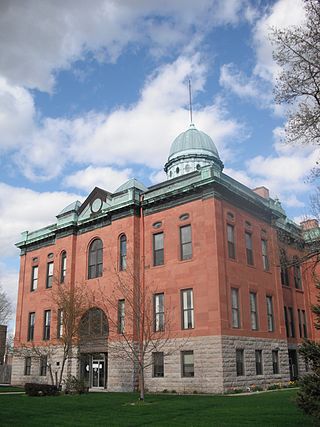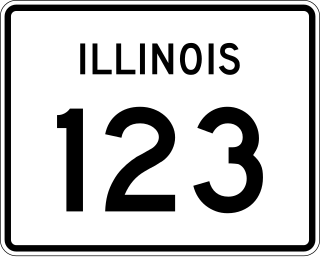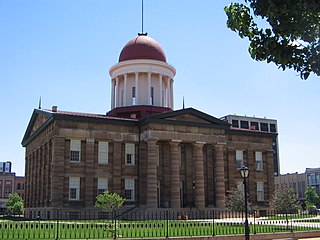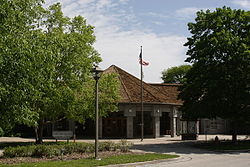
Springfield is the capital city of the U.S. state of Illinois and the county seat of Sangamon County. The city's population was 114,394 at the 2020 census, which makes it the state's seventh most-populous city, the second largest outside of the Chicago metropolitan area, and the largest in central Illinois. Approximately 208,000 residents live in the Springfield metropolitan area.

Sangamon County is a county located in the center of the U.S. state of Illinois. According to the 2020 census, it had a population of 196,343. Its county seat and largest city is Springfield, the state capital.

Petersburg is a city in and the county seat of Menard County, Illinois, United States, on the bluffs and part of the floodplain overlooking the Sangamon River. It is part of the Springfield, Illinois Metropolitan Statistical Area. The population was 2,258 at the 2020 census, nearly unchanged from 2010. Petersburg is located approximately 2 miles (3 km) north of New Salem, the original location where Abraham Lincoln first settled, as he started his career.

The Sangamon River is a principal tributary of the Illinois River, approximately 246 miles (396 km) long, in central Illinois in the United States. It drains a mostly rural agricultural area and runs through Decatur and Springfield. The river is associated with the early career of Abraham Lincoln and played an important role in early European settlement of Illinois, when the area around was known as the "Sangamon River Country". The section of the Sangamon River that flows through Robert Allerton Park near Monticello was named a National Natural Landmark in 1971.

Abraham Lincoln was born on February 12, 1809, in a one-room log cabin on the Sinking Spring farm, south of Hodgenville in Hardin County, Kentucky. His siblings were Sarah Lincoln Grigsby and Thomas Lincoln, Jr. After a land title dispute forced the family to leave in 1811, they relocated to Knob Creek farm, eight miles to the north. By 1814, Thomas Lincoln, Abraham's father, had lost most of his land in Kentucky in legal disputes over land titles. In 1816, Thomas and Nancy Lincoln, their nine-year-old daughter Sarah, and seven-year-old Abraham moved to what became Indiana, where they settled in Hurricane Township, Perry County, Indiana.

Illinois Route 97 (IL 97) is a north–south state highway in the central and western portions of the U.S. state of Illinois. It extends from I-55 Business in Springfield northwest to U.S. Highway 150 (US 150) near Galesburg. It crosses over the Illinois River on a bridge west of Havana. This is a distance of 102.23 miles (164.52 km).

Illinois Route 123 (IL-123) is an east–west state highway in central Illinois, USA. 33.72 miles (54.27 km) long, it stretches from Historic Route 66 at Williamsville to Illinois Route 125 near Pleasant Plains.
The Illinois Historic Preservation Division, formerly Illinois Historic Preservation Agency, is a governmental agency of the U.S. state of Illinois, and is a division of the Illinois Department of Natural Resources. It is tasked with the duty of maintaining State-owned historic sites, and maximizing their educational and recreational value to visitors or on-line users. In addition, it manages the process for applications within the state for additions to the National Register of Historic Places.

The Old State Capitol State Historic Site, in Springfield, Illinois, is the fifth capitol building built for the U.S. state of Illinois. It was built in the Greek Revival style in 1837–1840, when Springfield became the capital city, and served as the state house from 1840 to 1876. It is the site of candidacy announcements by Abraham Lincoln in 1858 and Barack Obama in 2007. It was designated a National Historic Landmark in 1961, primarily for its association with Lincoln and his political rival Stephen Douglas.

The Lincoln Log Cabin State Historic Site is an 86-acre (0.3 km2) history park located eight miles (13 km) south of Charleston, Illinois, U.S., near the town of Lerna. The centerpiece is a replica of the log cabin built and occupied by Thomas Lincoln, father of U.S. President Abraham Lincoln. Abraham Lincoln never lived here and only occasionally visited, but he provided financial help to the household and, after Thomas died in 1851, Abraham owned and maintained the farm for his stepmother, Sarah Bush Lincoln. The farmstead is operated by the Illinois Historic Preservation Agency.
The Lincoln Trail Homestead State Park and Memorial is a 162-acre (66 ha) state park located on the Sangamon River in Macon County near Harristown, Illinois, United States.

Central Illinois is a region of the U.S. state of Illinois that consists of the entire central third of the state, divided from north to south. Also known as the Heart of Illinois, it is characterized by small towns and mid-sized cities. Agriculture, particularly corn and soybeans, as well as educational institutions and manufacturing centers, figure prominently.
The Beardstown and Sangamon Canal was a canal plan developed in the mid-1830s, with avid backing by Abraham Lincoln, then an Illinois state legislator, to make large portions of the Sangamon River between Springfield, Illinois, and Beardstown, Illinois, navigable via a canal to the junction with the Illinois River, which in turn flows into the Mississippi River.
James D. Henry was a militia officer from the U.S. state of Illinois who rose to the rank of general during the Black Hawk War. Henry was born in Pennsylvania in 1797, and moved to Edwardsville, Illinois in 1822. In 1825, while living in Edwardsville, he was indicted with two other men for the murder of an acquaintance, though he never went to trial. One defendant was tried but found not guilty, and following the trial Henry moved to Springfield, Illinois, where he was elected sheriff. When the Winnebago War broke out in 1827 Henry acted as adjutant for four companies of volunteers.

Abraham Lincoln's patent relates to an invention to buoy and lift boats over shoals and obstructions in a river. Abraham Lincoln conceived the invention when on two occasions the boat on which he traveled got hung up on obstructions. Lincoln's device was composed of large bellows attached to the sides of a boat that were expandable due to air chambers. Filed on March 10, 1849, Lincoln's patent was issued as Patent No. 6,469 later that year, on May 22. His successful patent application led to his drafting and delivering two lectures on the subject of patents while he was president.
Clayville is a former roadside hamlet, inhabited from 1824 into the 1850s, located in Cartwright Township near Pleasant Plains, Illinois, United States. The settlement was never large but was firmly centered on a once-thriving tavern on the main road between the state capital of Springfield and the Illinois River port of Beardstown. The Broadwell Tavern continues to stand on its original foundation today as a reminder of the once-active frontier settlement.

Ossian M. Ross was a pioneer farmer, stock-raiser, and merchant in Illinois, who served as a major in the War of 1812 and subsequently founded the Illinois towns of Lewistown and Havana, and who also played a prominent role in establishing Fulton and Mason counties in that state.

Relief was a stern-wheel steamboat that operated on the Columbia and Willamette rivers and their tributaries from 1906 to 1931. Relief had been originally built in 1902, on the Columbia at Blalock, Oregon, in Gilliam County, and launched and operated as Columbia, a much smaller vessel. Relief was used primarily as a freight carrier, first for about ten years in the Inland Empire region of Oregon and Washington, hauling wheat and fruit, and after that was operated on the lower Columbia river.

The Lincoln-Berry General Store was a general store that was co-owned by Abraham Lincoln. The store is one of the reconstructed 1830s buildings at Lincoln's New Salem, a state historic site. It was and is the only frame building in New Salem.





















